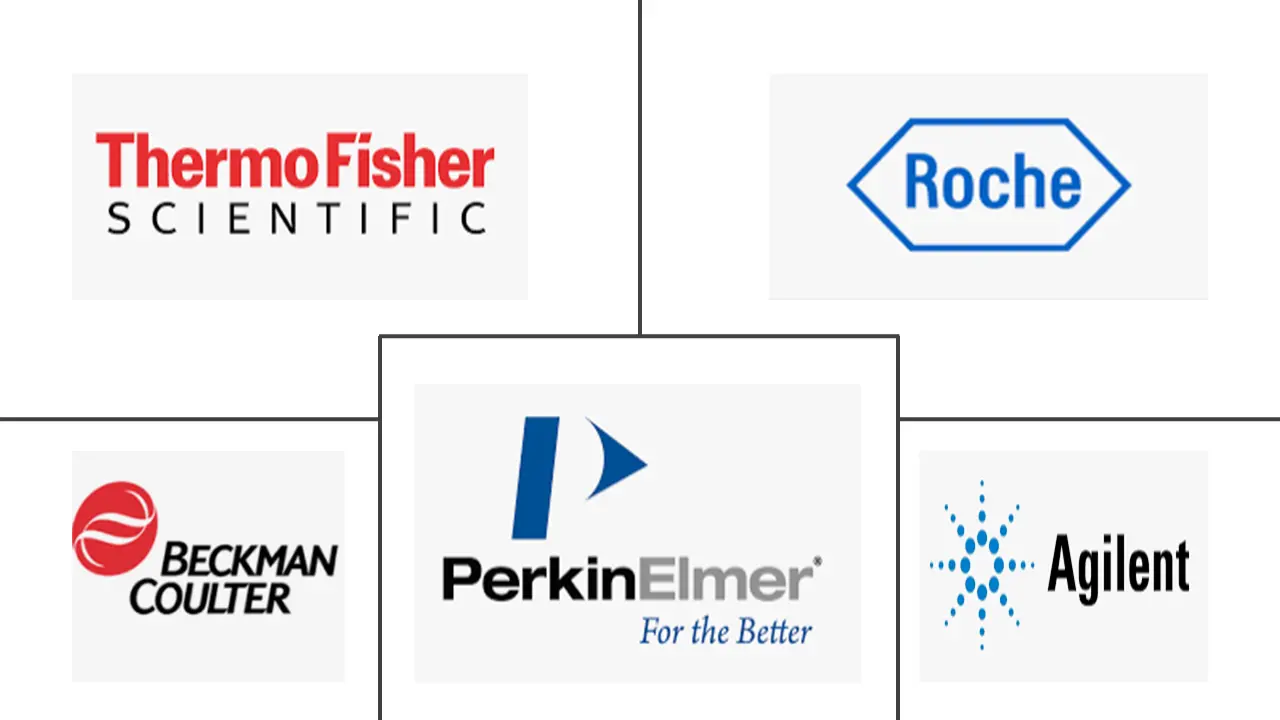Lab Automation in Protein Engineering Market Size and Share
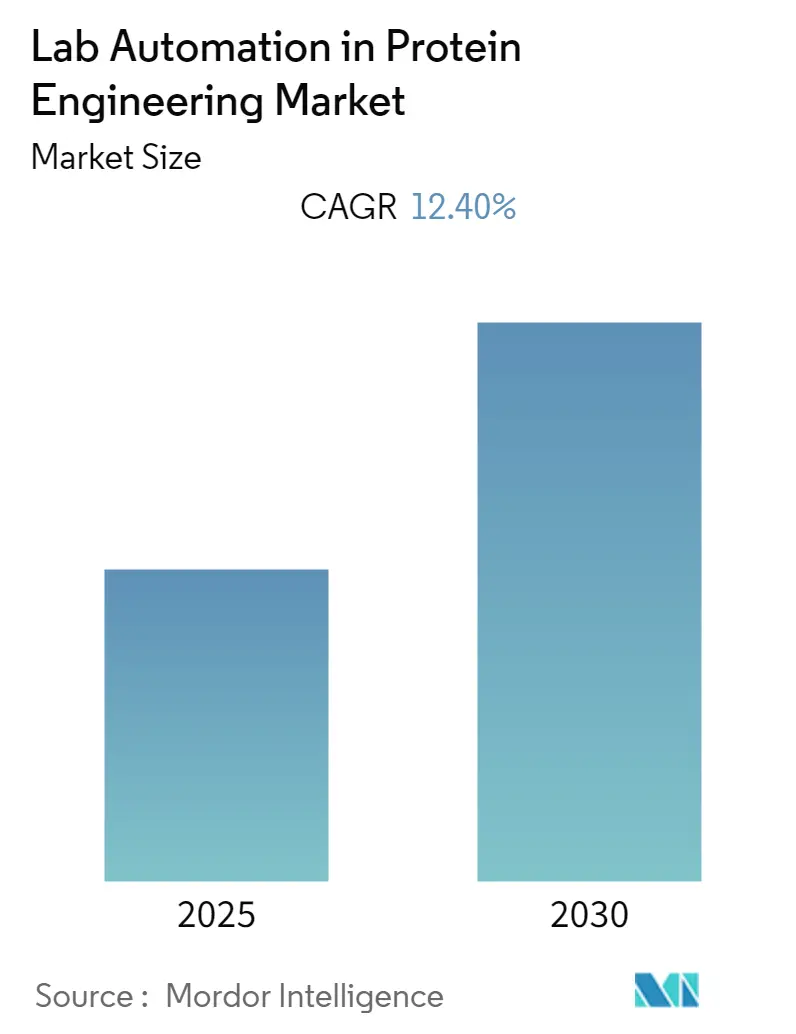
Lab Automation in Protein Engineering Market Analysis by Mordor Intelligence
The Lab Automation in Protein Engineering Market is expected to register a CAGR of 12.4% during the forecast period.
- Protein-energy malnutrition (PEM) is rising in emerging economies' rural communities. It refers to a collection of illnesses that includes kwashiorkor, marasmus, and marasmus-kwashiorkor transitional phases. As a result, the incidence of kwashiorkor varies by region. It is pretty uncommon in the United States. Central America, Southeast Asia, Congo, Jamaica, Puerto Rico, and South Africa are impacted. As a result, the rising frequency of protein-deficiency illnesses boosts total market demand.
- The healthcare business has been affected by a growing number of government efforts, such as sponsoring R&D for protein engineering and awareness programs. As a result, the government is funding several research initiatives ahead of time. For example, Protein Technologies Ltd (PTL) obtained money from the UK government's Technology Strategy Board (now Innovate UK) for their ground-breaking protein engineering research.
- Protein engineering also has great potential in the agrochemical business because it can lead to better-functioning enzymes, boost crop yields, or make biofuel production easier. It is also anticipated to play a vital role as a technique for achieving the higher agricultural outcomes required to satisfy future needs.
- Since the outbreak of COVID-19, labs have been turning their premises and resources into COVID-19 testing facilities, increasing automation equipment use. The University of Washington's laboratories were the first to do so. The statement came after the Broad Institute announced that its clinical processing lab would be converted into a large-scale COVID-19 testing facility.
Global Lab Automation in Protein Engineering Market Trends and Insights
Automated Liquid Handler Equipment Accounted for the Largest Market Share
- Liquid handlers are usually employed in biochemical and chemical laboratories. Automated liquid handling robots help in dispensing samples and other fluids in laboratories. Automated liquid handlers minimize run times and maximize accuracy. Moreover, liquid handlers can operate across a wide range of volumes, extending into nanolitres, thus proving their usefulness in dispensing operations.
- Leading companies have set the benchmark for the development of automated liquid handlers and are constantly investing in developing premium products to increase productivity effectively. The evolution of liquid handlers, capable of handling minute volumes of liquids, has contributed to the rapid development of modular lab automation systems in the market.
- According to the Robotic Industries Association, the life science sector has the third-highest growth in industrial robots, in terms of automated liquid handlers, automated plate handlers, robotic arms, and others, to meet the demand.
- According to Parker, one of the trends in life science robotics is fluidics getting more straightforward in robotic analyzers. This trend arose because clinical laboratories and hospitals cannot afford an instrument to go down when critical samples are involved. Specific robotic systems that used to have 50 needles on the end of a dispensing unit and lots of tubing increasingly use special valve manifolds that eliminate the need for tubing and result in less chance of failure. The manifolds minimize the possibility of leakage.
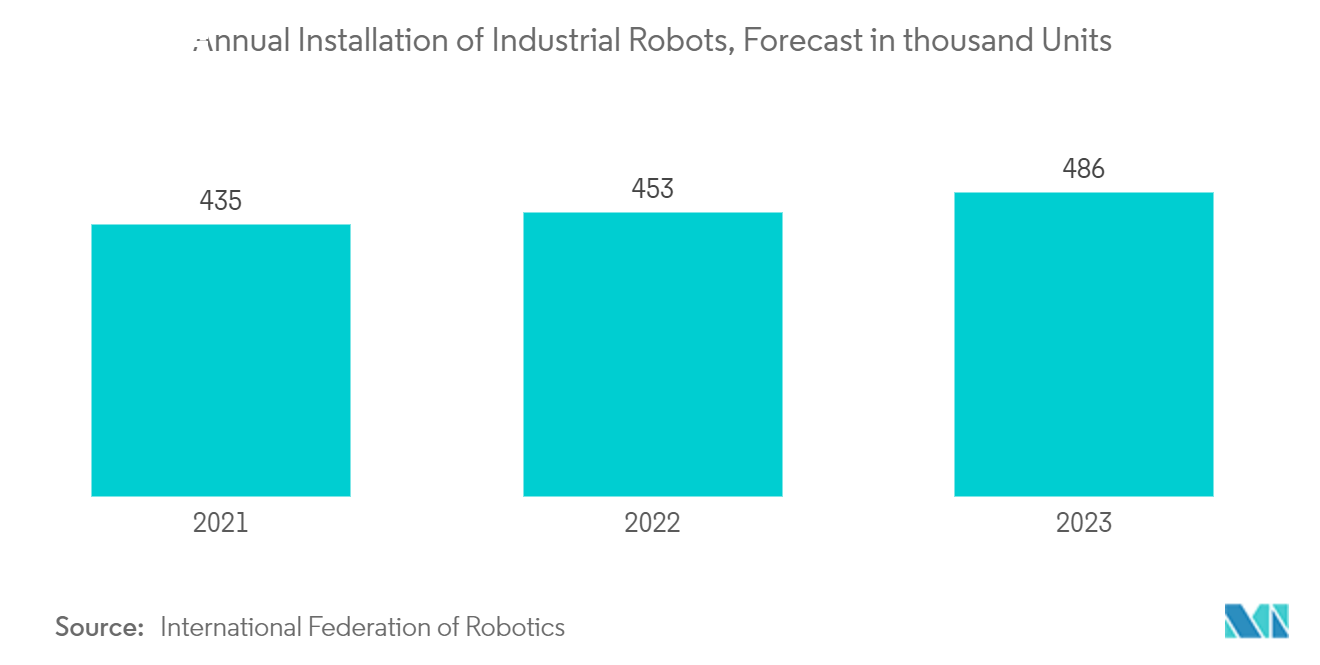
North America Occupied the Largest Market Share
- North America has been a pioneer in clinical research for years. This region is home to major pharmaceutical companies, like Pfizer, Novartis, GlaxoSmithKline, J&J, and Novartis. The part also has the highest concentration of contract research organizations (CROs). Some significant CROs are Laboratory Corp. of America Holdings, IQVIA, Syneos Health, and Parexel International Corp. Owing to the presence of all the major players in the industry and stringent FDA regulations; the market is very competitive in the region. To gain an advantage over competitors, the genomics research organizations in the area are increasingly adopting robotics and automation in labs.
- The genomic industry, especially in the United States, is still growing and is expected to increase over the coming years. The availability of new genome sequencing technologies, well-established healthcare infrastructure, and the increasing geriatric population are significant contributing factors to revenue growth. In the United States, the need to accommodate growth and the drive to boost efficiency are priming blood centers to acquire fully automated walkaway systems to perform types and screens or test specimens for infectious diseases.
- Many companies are involved in innovation due to their extensive R&D capabilities. Individual areas of automation can encompass purification, protein engineering, compound synthesis, biological testing, and analysis in the lab equipped with a Magnamotion track.
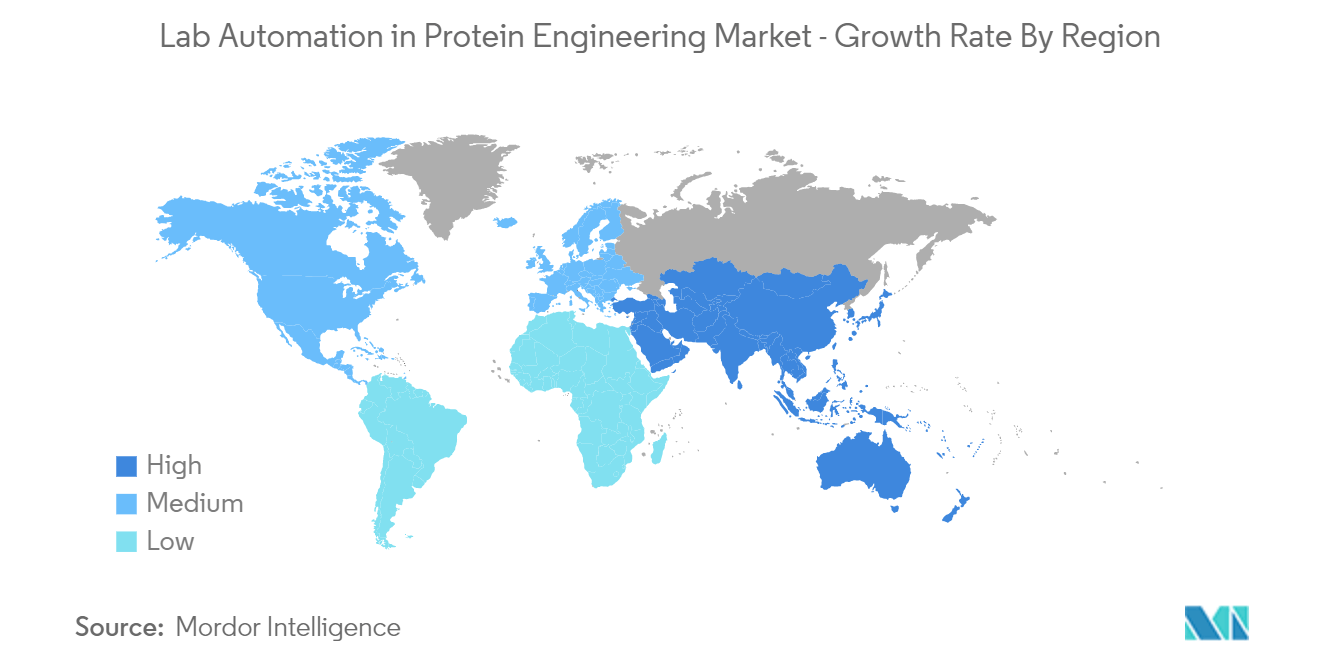
Competitive Landscape
The lab automation in protein engineering market is moderately competitive, owing to many small and big players exporting products to many countries. The key strategies adopted by the major players are technological advancement in development, partnerships, and merger and acquisition. Some of the major players in the market are Thermo Fisher Scientific Inc., F. Hoffmann-La Roche Ltd, Siemens Healthineers, Danaher Corporation, and PerkinElmer. Some of the recent developments in the market are:
- January 2023 - BD (Becton, Dickinson and Company), a leading medical technology provider, unveiled a new robotic track system for the BD Kiestra microbiology laboratory solution worldwide. This system automates the processing of lab specimens, which could help to cut down on manual labor. The new BD Kiestra 3rd Generation Complete Lab Automation System is expandable to fit the specific demands of labs and allows them to connect several BD Kiestra modules in a flexible and customized total lab automation configuration.
Lab Automation in Protein Engineering Industry Leaders
-
Agilent Technologies Inc.
-
Thermo Fisher Scientific
-
PerkinElmer, Inc.
-
Beckman Coulter Inc.
-
Roche Holding AG
- *Disclaimer: Major Players sorted in no particular order
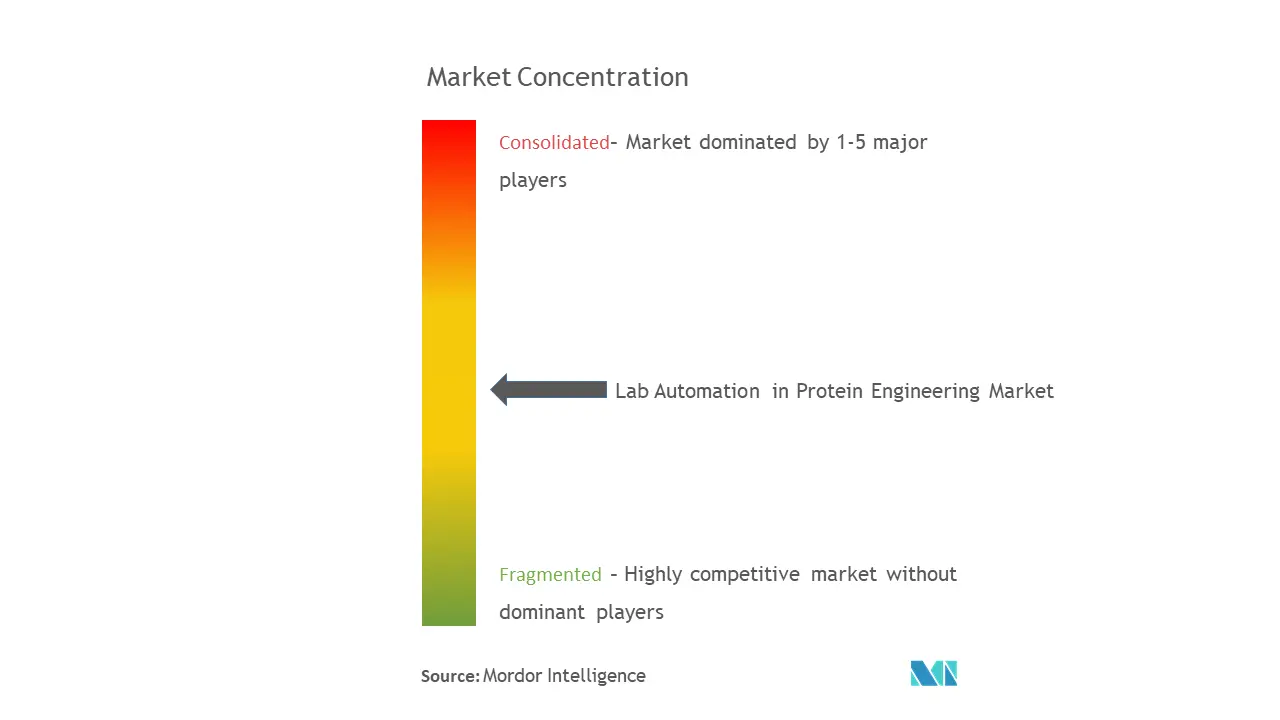
Recent Industry Developments
- October 2022 - Thermo Fisher Scientific releases the first fully automated, all-in-one sample preparation system. The new EXTREVA ASE Accelerated Solvent Extractor from Thermo Scientific is the first system to automatically extract and concentrate analytes of interest from solid and semi-solid samples, such as persistent organic pollutants (POPs), polycyclic aromatic hydrocarbons (PAHs), or pesticides, in a single instrument, obviating the need for manual sample transfer for a walk-away sample-to-vial workflow.
- March 2022 - The CellMek SPS is a potent remedy for the manual sample preparation and data management bottlenecks in clinical flow cytometry introduced by Beckman Coulter Life Sciences, a subsidiary of Danaher Corporation and a world leader in life sciences lab automation and innovation. This fully automated sample preparation system (SPS) provides on-demand processing for various sample types to assist laboratories in enhancing their capabilities. The CellMek SPS combines features that enable lean workflows and boost lab productivity by simplifying and automating several antiquated and labor-intensive preparatory techniques, building on a long tradition of lab automation.
Global Lab Automation in Protein Engineering Market Report Scope
Scientists always look for improved accuracy, higher throughput, and reduced cost during advanced gene sequencing. An automated system allows laboratories to increase the effectiveness of their workstation for protein engineering. In the past few years, protein engineers have successfully generated a wide range of proteins tailored to specific health, industry, medicine, research, and biotechnology applications.
The Lab Automation in Protein Engineering Market is segmented by Equipment (Automated Liquid Handlers, Automated Plate Handlers, Robotic Arms, and Automated Storage and Retrieval Systems) and Geography. The market sizes and forecasts are provided in terms of value (USD million) for all the above segments.
| Automated Liquid Handlers |
| Automated Plate Handlers |
| Robotic Arms |
| Automated Storage and Retrieval Systems (AS/RS) |
| Other Equipment |
| North America |
| Europe |
| Asia-Pacific |
| Rest of the World |
| By Equipment | Automated Liquid Handlers |
| Automated Plate Handlers | |
| Robotic Arms | |
| Automated Storage and Retrieval Systems (AS/RS) | |
| Other Equipment | |
| By Geography | North America |
| Europe | |
| Asia-Pacific | |
| Rest of the World |
Key Questions Answered in the Report
What is the current Lab Automation in Protein Engineering Market size?
The Lab Automation in Protein Engineering Market is projected to register a CAGR of 12.4% during the forecast period (2025-2030)
Who are the key players in Lab Automation in Protein Engineering Market?
Agilent Technologies Inc., Thermo Fisher Scientific, PerkinElmer, Inc., Beckman Coulter Inc. and Roche Holding AG are the major companies operating in the Lab Automation in Protein Engineering Market.
Which is the fastest growing region in Lab Automation in Protein Engineering Market?
Asia-Pacific is estimated to grow at the highest CAGR over the forecast period (2025-2030).
Which region has the biggest share in Lab Automation in Protein Engineering Market?
In 2025, the North America accounts for the largest market share in Lab Automation in Protein Engineering Market.
What years does this Lab Automation in Protein Engineering Market cover?
The report covers the Lab Automation in Protein Engineering Market historical market size for years: 2019, 2020, 2021, 2022, 2023 and 2024. The report also forecasts the Lab Automation in Protein Engineering Market size for years: 2025, 2026, 2027, 2028, 2029 and 2030.
Page last updated on:
Lab Automation in Protein Engineering Market Report
Statistics for the 2025 Lab Automation in Protein Engineering market share, size and revenue growth rate, created by Mordor Intelligence™ Industry Reports. Lab Automation in Protein Engineering analysis includes a market forecast outlook for 2025 to 2030 and historical overview. Get a sample of this industry analysis as a free report PDF download.
